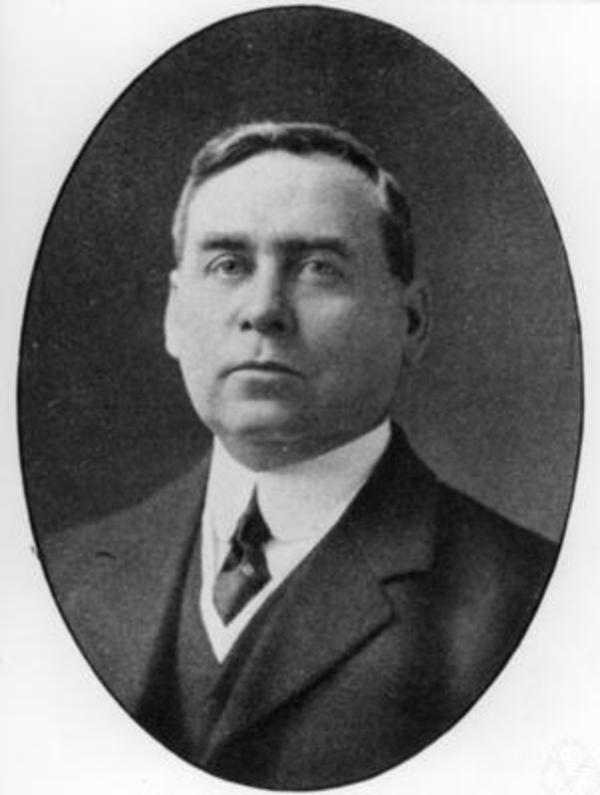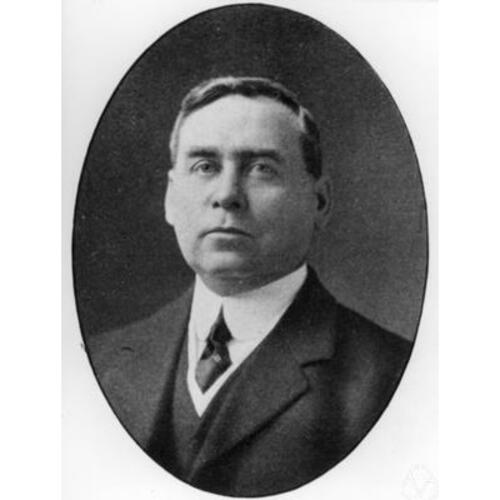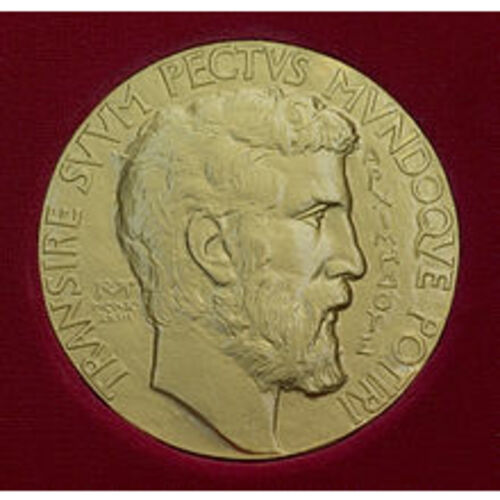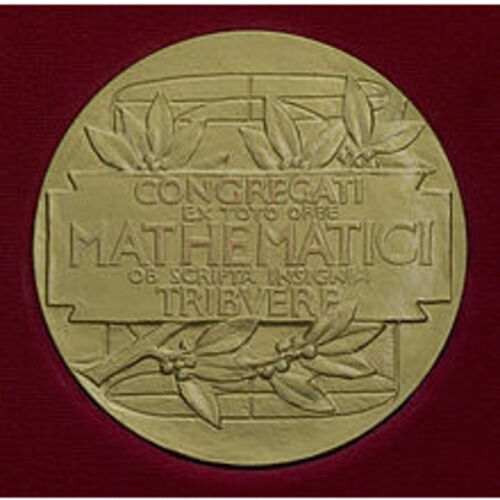
Source: Courtesy of Wikimedia Commons
FIELDS, JOHN CHARLES, mathematician, university professor, and founder of the international medal for mathematics research known as the Fields Medal; b. 14 May 1863 in Hamilton, Upper Canada, son of John Charles Fields and Henrietta (Harriet) Bowes; d. unmarried 9 Aug. 1932 in Toronto and was buried two days later in Hamilton Cemetery.
J. C. Fields’s maternal forebears came from the village of Newbliss (Republic of Ireland) and settled in Upper Canada on a farm near Milton. Of his paternal family, less is known; his father was born in Coteau-du-Lac, Lower Canada. In 1858 Fields Sr opened what became a successful leather business, directed mainly at the shoe trade, on King Street in Hamilton. That year he lost his first wife, and in 1859 he married Harriet Bowes, a schoolteacher in Oakville. Over time he purchased other property in downtown Hamilton that he rented out. After he died suddenly in 1874 at the age of 40, his widow oversaw family affairs until her own early death in 1881, when Fields was 18. His parents’ careful financial management left a sufficient income for their three children to retain the family home and for Fields to attend university.
In Fields’s youth, Hamilton was known for the excellence of two of its public schools, Central School and Hamilton Collegiate Institute, and he was a pupil at both. The institute’s students repeatedly won awards in classics and mathematics, their success due chiefly to principal and classicist George Dickson and mathematics teacher William Henry Ballard. In 1880 Fields took the gold medal in mathematics at the matriculation examinations for the University of Toronto. Since his mother was seriously ill, however, he remained in Hamilton, completing his first academic year through independent study. Following her death, he enrolled at the university in his second year; he would graduate as the gold medallist in mathematics in 1884.
He proceeded immediately to Johns Hopkins University in Baltimore, Md, and obtained his phd in 1887. After two further years there as a teaching fellow, he took up an appointment in mathematics at Allegheny College in Meadville, Pa, where he stayed until 1892. Realizing that his interests lay in research, and aided by his small inheritance, he moved to Europe as a postdoctoral scholar; he spent two years in Paris, six months in Göttingen (Germany) studying under Felix Klein, and five years in Berlin. As a record of his time in Berlin, he kept 111 books of lecture notes, now in the archives of the University of Toronto. His observations on higher education in Germany were put forward in an article entitled “The German university and German university mathematics” (1903). Fields’s linguistic skills, amiability, and social ease brought him a large circle of friends and scientific contacts with whom he would renew his acquaintance during frequent travels to Europe and the United States. In 1901, his former mathematics professor James Loudon*, who had become president of the University of Toronto, hired Fields to give a series of lectures. The following year Fields received a permanent appointment as special lecturer in his discipline.
Over the years Fields published 38 mathematical articles. These would be listed by his phd student Samuel Beatty as an addendum to an obituary written for the Royal Society of London by Fields’s friend and colleague John Lighton Synge. In 1906 Fields brought out his only book, Theory of the algebraic functions of a complex variable (Berlin), which affirmed his reputation as the pre-eminent mathematician in Canada before World War I. Promotions at the university followed quickly, and he was elected a fellow of the Royal Society of Canada (1909) and the Royal Society of London (1913). It is not, however, as a scientist that Fields is remembered. In an era of great mathematicians such as Klein, David Hilbert, and Henri Poincaré in Europe and of a strong emerging research tradition in the United States, Fields was a minor figure. His work was overtaken even during his lifetime by a modern algebraic approach and is now seen as a footnote by those interested in the Fields Medal.
What Fields brought to the University of Toronto in 1902 was his conviction of the significance of scientific research arising from his experiences at Johns Hopkins and the University of Berlin. Toronto lagged in experimental work despite Loudon’s efforts to encourage it. The university lacked money. Its professors were overloaded by the need to teach a growing student body. There was as yet no understanding of the importance of research to a strong industrial economy, although this situation was to change with the outbreak of World War I in 1914. Among the voices linking research and industry, Fields’s was foremost within the university, at the Canadian Institute (Royal Canadian Institute from 1914), and in local newspapers. Fields also brought to Canada an international outlook on the unity of science and the need for international cooperation.
In Canada, none of Fields’s personal papers survive and little of his other correspondence. There are, however, letters and records in archives around the world that indicate the wide range of his communications. In addition to his article on the German university, Fields wrote on the Norwegian mathematician Niels Henrik Abel, the American philanthropist John Davison Rockefeller, and the connection of science to industry. Shortly before his death, he compiled a retrospective account of mathematics in Canada. As president of the Royal Canadian Institute (1919–25), he was tireless in his efforts to make the organization a centre of active research rather than a forum for scientific discussion. He sought to establish a graduate school at the University of Toronto with its own separate faculty. He also attempted to gain support for a national academy of science modelled on European academies. Ahead of Canadian opinion in all these matters, he was unsuccessful.
World War I fractured international mathematical cooperation along battle lines. At war’s end the rift continued, and it was formalized in 1918–19 when Allied scientists established the International Research Council. Its founding declaration, adopted in 1918 at the Inter-Allied Conference on International Scientific Organizations in London, attributed all war guilt to Germany. The purpose of the IRC was to exclude scientists from the former Central Powers – Germany, Austria, Hungary, Bulgaria, and Turkey – from international scientific associations. A number of scientists from neutral and Allied countries objected to the policy. Among these were mathematicians Magnus Gustaf (Gösta) Mittag-Leffler (Sweden) and Godfrey Harold Hardy (Great Britain) and astronomer Jacobus Cornelius Kapteyn (Netherlands). Despite their objections, at the International Congress of Mathematicians in Strasbourg in 1920, the International Mathematical Union was founded along discriminatory lines. Leadership of the IMU was in the hands of Charles-Jean de La Vallée Poussin (Belgium) and Émile Picard (France), both strong exclusionists. The atmosphere at Strasbourg was bitter. During the congress Leonard Eugene Dickson (United States) proposed holding the 1924 ICM in New York, away from the difficult European atmosphere. He hoped that by then the rupture among mathematicians would be resolved, but it was not. When the American Mathematical Society could not agree to the ban on mathematicians from Germany and its allies, a casual suggestion was made that the congress should take place in Toronto. Fields jumped at the chance.
Fields accepted the stricture on participation by mathematicians from the former Central Powers, but was determined to make the meeting as international as possible under the circumstances. He travelled to Europe in 1923 and 1924 to encourage attendance. Fields raised $70,000 from the Ontario and Canadian governments to offset the high cost of travel for mathematicians from abroad. He also increased the scope of the congress by broadening the definition of mathematics so that practical users of its lessons in such areas as engineering, insurance, and meteorology could be included. The International Mathematical Congress in Toronto, the only ICM so named, was unexpectedly successful within its limitations: 444 mathematicians from 33 countries were present. The exertions of organizing the congress and editing the Proceedings that followed, however, undermined the health of the 61-year-old Fields.
Disregarding the exclusionist policy of the IMU, Salvatore Pincherle invited mathematicians from all countries to attend the 1928 ICM in Bologna, Italy. Among the more than 800 delegates were 76 German mathematicians, 56 from France, and 10 from Belgium. Although Germany had been asked to join the IMU in 1925, its mathematicians remained outside the organization because of the 1918 statement on war guilt. Therefore the rift continued. Fields considered himself to be persona grata to French and Germans alike, and he would go to Europe in 1929, 1930, and 1931 to see what he might do to mend relations. Though unsuccessful in this endeavour, during these years of quiet diplomacy he conceived the idea of an international medal in mathematics.
When the final financial reckoning was made after the publication in 1928 of the Toronto Proceedings, there was a balance of around $2,700, which Fields proposed using for the medal. In December 1930 he successfully sought support from the AMS for his idea and he subsequently enlisted mathematical societies in Europe as well. He also consulted widely on the design of the medal and in 1932 corresponded with Robert Tait McKenzie, a Canadian physician and sculptor at the University of Pennsylvania. Whether Fields saw a preliminary sketch or a prototype of McKenzie’s model has not been ascertained. He died on 9 Aug. 1932. His friend and colleague John Lighton Synge completed Fields’s arrangement with McKenzie and with the IMU, which accepted the medal in October 1932 at the Zürich ICM.
The earliest known facsimile of the medal, cast in bronze and dated 1933, is held at the Fields Institute for Research in Mathematical Science, Toronto. In his will Fields had specified two small personal annuities, leaving the rest of his estate of some $45,000 to provide a modest prize to accompany each medal. The first Fields medals were awarded at the Oslo ICM in 1936, and the first with prize money at the 1950 ICM in Cambridge, Mass. According to Fields’s wishes, an international committee of the IMU selects the winners, but the medal itself can be considered to be peculiarly Canadian. The residue of Fields’s estate used to support it continues to be administered by the University of Toronto, and the medal is struck at the Royal Canadian Mint every four years from McKenzie’s original dies. Inaugurated in the early 1930s, in the midst of renewed and rising nationalism, Fields’s medal was a singular international gesture.
This biography is based on the authors’ full-length study Turbulent times in mathematics: the life of J. C. Fields and the history of the Fields medal (Providence, R.I., 2011).
John Charles Fields’s mathematical publications are listed by Samuel Beatty on the final three pages of J. L. Synge’s “John Charles Fields, 1863–1932,” Royal Soc. of London, Obit. notices of fellows, 1 (1932–35): 131–38. His non-mathematical publications are “The Abel centenary,” Univ. of Toronto Monthly, 3 (1902–3): 184–91; “The German university and German university mathematics,” Ont. Educational Assoc., Proc. (n.p.), 1903: 274–95; Science and industry ([Toronto?, 1918?]) (address to the members of the Board of Trade in Toronto, 28 March 1918); Universities, research and brain waste (Toronto, 1920) (president’s address, Royal Canadian Instit., 8 Nov. 1919); “Rockefeller’s service to mankind,” Saturday Night, 2 Nov. 1929: 2; and “The Royal Society of Canada and Canadian mathematics,” in RSC, Fifty years retrospect: anniversary volume, 1882–1932 (Toronto, 1932), 107–12.
Fields’s extant correspondence and other letters bearing on the 1924 mathematical congress in Toronto may be found in the James Loudon papers (B1972-0031/014(12)) and the Robert Falconer papers (A1967-0007/RSIN 0002) at UTARMS, and in the R. B. Bennett fonds (R11336-0-7) and the International Mathematical Congress file (R219-100-6, vol.1373, no.1924—347) at LAC. Correspondence and records related to the Royal Canadian Instit. are in ms coll. 00193 at the Univ. of Toronto, Thomas Fisher Rare Book Library, and in F 1052-6-0-8 at AO.
Studies of Fields and his medal are presented in H. S. Tropp, “The origins and history of the Fields Medal,” Historia Mathematica (Toronto), 3 (1976): 167–81; Carl Riehm, “The early history of the Fields Medal,” American Mathematical Soc., Notices (Providence), 49 (2002): 778–82; and J. L. Synge, “John Charles Fields,” London Mathematical Soc., Journal (London), 8 (1933): 153–60 (copy at the Dublin Instit. for Advanced Studies, School of Theoretical Physics, Arch., J. L. Synge papers).
Cite This Article
Frances Hoffman and Elaine McKinnon Riehm, “FIELDS, JOHN CHARLES,” in Dictionary of Canadian Biography, vol. 16, University of Toronto/Université Laval, 2003–, accessed December 19, 2025, https://www.biographi.ca/en/bio/fields_john_charles_16E.html.
The citation above shows the format for footnotes and endnotes according to the Chicago manual of style (16th edition). Information to be used in other citation formats:
| Permalink: | https://www.biographi.ca/en/bio/fields_john_charles_16E.html |
| Author of Article: | Frances Hoffman and Elaine McKinnon Riehm |
| Title of Article: | FIELDS, JOHN CHARLES |
| Publication Name: | Dictionary of Canadian Biography, vol. 16 |
| Publisher: | University of Toronto/Université Laval |
| Year of publication: | 2017 |
| Year of revision: | 2017 |
| Access Date: | December 19, 2025 |





